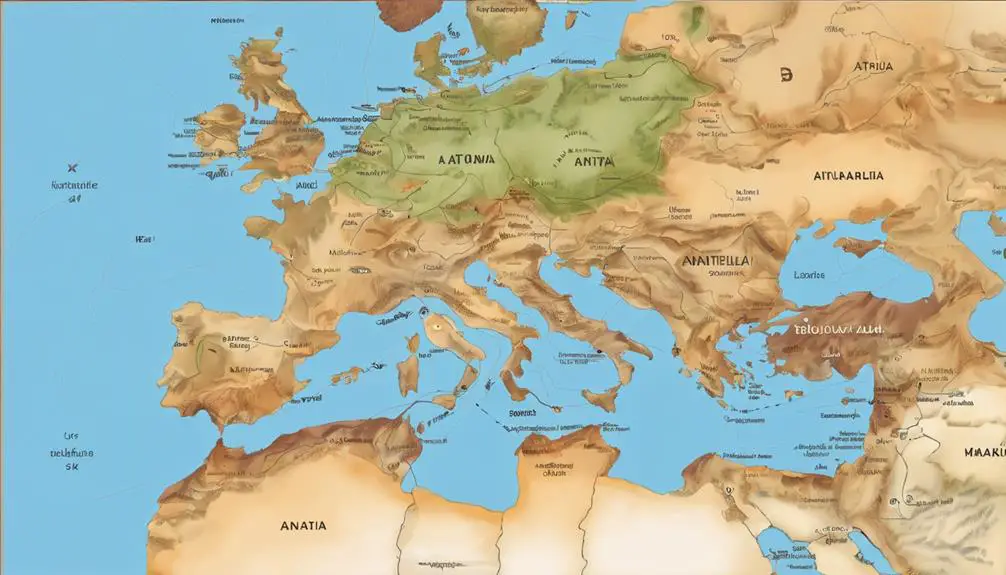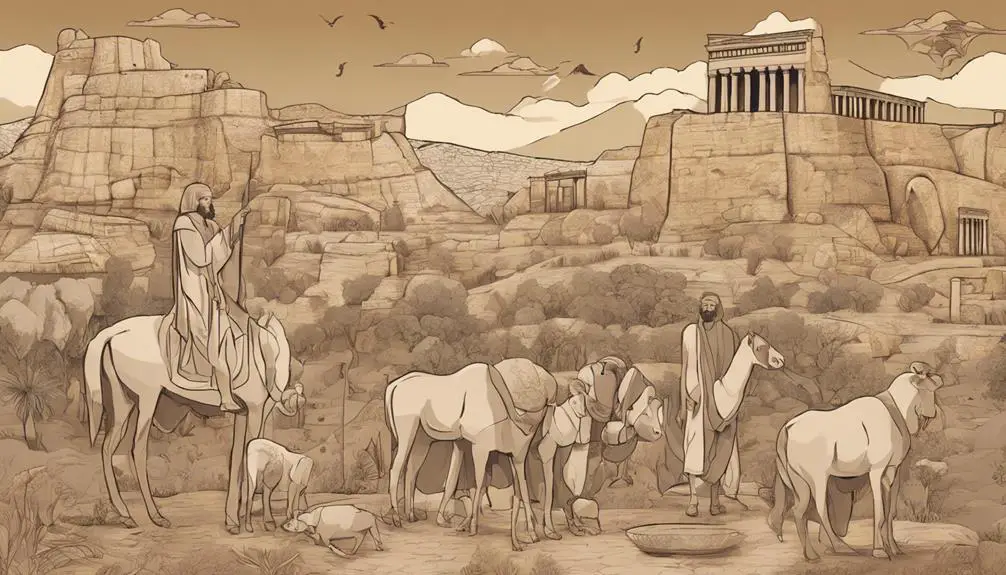Traverse the ancient landscapes of Anatolia to uncover how its biblical history shapes faith and prophecy, revealing secrets yet untold.

Anatolia in the Bible
As you stand at the crossroads of history and faith, Anatolia beckons with stories woven into the very fabric of the Bible. You'll find its mountains, valleys, and ancient cities embedded in the narratives of the Old Testament and the travels of Apostle Paul.
This region, rich in prophetic tradition, hosted early Christian communities and the Seven Churches of Revelation, making it a cornerstone of biblical history. What secrets do these ancient lands hold, and how do they shape our understanding of biblical events and teachings?
Let's embark on a journey to uncover the spiritual and historical significance of Anatolia, where each discovery might just offer a new perspective on familiar stories.
Key Takeaways
- Anatolia's strategic location made it a significant backdrop for biblical narratives and apostolic journeys.
- Early Christian communities in Anatolia were pivotal for the spread and development of Christianity.
- Prophetic voices in Anatolia critiqued societal norms and played key roles in spiritual transformation.
- The region hosted important theological debates, contributing to the formation of foundational Christian creeds.
The Geographic Significance of Anatolia

Anatolia's strategic position bridged continents, shaping the cultural and historical narratives within the Bible. Its unique location, nestled between Europe and Asia, made it a crossroads for various civilizations throughout antiquity. This intersection facilitated a network of Anatolian trade routes that were pivotal for the movement of goods, ideas, and cultures across the known world. You'll find that these routes didn't just carry spices or textiles; they were conduits for cultural exchanges that profoundly impacted the societies they touched.
The influence of these interactions can be seen in the way religious, philosophical, and artistic ideas flowed freely across borders, contributing to the rich tapestry of cultural heritage in the region. This exchange wasn't one-sided; it was a dynamic process that saw Anatolia both influence and be influenced by the civilizations it connected. The region absorbed elements from the Mesopotamian, Egyptian, Hittite, and later, Greek and Roman cultures, synthesizing them into something distinctly Anatolian yet universally relevant.
Moreover, the economic prosperity brought about by these trade routes allowed for the development of sophisticated urban centers. These cities became melting pots of diversity, where different cultures and religions coexisted and interacted. This cosmopolitan nature of Anatolian society is crucial for understanding the backdrop against which biblical narratives unfolded.
Anatolia in Old Testament Narratives

Within the Old Testament, the region of Anatolia emerges as a significant backdrop, influencing narratives and shaping the interactions of its characters. This geographical area, known for its complex history and diverse cultures, plays a pivotal role in the biblical narrative, particularly through its interactions with the Hittites and the Assyrian campaigns.
The Hittite interactions, for instance, are crucial to understanding the geopolitical dynamics of the time. The Hittites, a powerful empire in Anatolia, are mentioned in various parts of the Old Testament, impacting the Israelites directly and indirectly. Their presence and the treaties they formed with other nations provide insight into the diplomatic practices of the era.
Assyrian campaigns into the region further highlight Anatolia's significance. The Assyrian Empire's military expeditions affected not only the geopolitical landscape of Anatolia but also the broader Near East, impacting the historical context within which the Old Testament narratives were set.
To visualize these interactions and their significance, consider the following table:
Aspect |
Hittite Interactions |
Assyrian Campaigns |
|---|---|---|
Influence |
Diplomatic treaties, cultural exchanges |
Military conquests, territorial expansion |
Narratives |
Genesis accounts, Kings' references |
Prophetic books, historical accounts |
Impact |
Shaping regional dynamics |
Altering geopolitical landscapes |
Through these lenses, you can appreciate the depth of Anatolia's influence on the Old Testament narratives. It wasn't merely a backdrop but a dynamic participant that shaped the course of biblical history, highlighting the intricate interplay between geography and divine storytelling.
The Journeys of Apostle Paul

Moving beyond the Old Testament, the New Testament narratives bring to light the transformative journeys of Apostle Paul across Anatolia. As you delve into these accounts, you encounter a rich tapestry of travels that not only shaped the early Christian church but also left an indelible mark on the lands he traversed. Paul's companions, pivotal figures in their own right, played crucial roles in these endeavors, offering support, spreading the teachings of Jesus, and contributing to the establishment of early Christian communities throughout the region.
Analyzing Paul's journeys, you'll find that shipwreck incidents weren't merely obstacles; they were significant events that influenced the course of his missions. One notable incident, as documented in Acts, occurred off the coast of Malta, but it's the implications of these shipwrecks on his travels in Anatolia that capture your attention. They underscore the perilous nature of Paul's missions, highlighting his resilience and unwavering commitment to his cause.
The scholarly examination of Paul's itineraries reveals a complex network of routes that facilitated not only the spread of Christianity but also the exchange of cultural and religious ideas across Anatolia. His interactions with diverse communities, his confrontations with both Jewish and Roman authorities, and his enduring legacy in these lands underscore the transformative impact of his journeys.
The Seven Churches of Revelation

Delving into the New Testament, the Seven Churches of Revelation represent a fascinating aspect of early Christian development in Anatolia, shedding light on the spiritual and communal dynamics of the time. These churches, addressed by John in the Apocalypse, offer a unique lens through which to view the interplay between church architecture and apocalyptic symbolism, revealing much about the theological and social contexts of early Christianity.
The significance of the Seven Churches can be dissected as follows:
- Ephesus: Known for its grandeur in church architecture, Ephesus symbolizes the fervor of early Christian communities, while also cautioning against losing one's first love for Christ.
- Smyrna: Despite its lack of archaeological prominence, Smyrna's resilience in the face of persecution embodies the eternal hope found in faith, highlighting the apocalyptic promise of overcoming.
- Pergamum: Situated in a city known for its towering acropolis, the church in Pergamum navigates the tension between pagan surroundings and Christian witness, mirroring the struggle of maintaining doctrinal purity.
- Thyatira, Sardis, Philadelphia, Laodicea: These churches collectively reflect a spectrum of challenges and commendations, from dealing with internal heresies to maintaining faith in adversity, each contributing to a broader understanding of Christian endurance and the prophetic call to repentance.
Through these churches, one discerns the critical role of architecture in embodying theological concepts and the nuanced ways apocalyptic symbolism served to instruct, encourage, and rebuke the early Christian communities. This exploration not only enriches our understanding of early Christian life in Anatolia but also invites reflection on contemporary spiritual practices and community engagement.
Prophets and Prophecies in Anatolia

Turning our attention to the realm of prophets and prophecies in Anatolia, we encounter a rich tapestry of divine messages that further illuminate the spiritual landscape of this ancient region. The interplay between prophetic traditions and the historical conflicts that shaped Anatolia's past reveals a complex narrative of divine intervention and human response.
Prophets in Anatolia navigated a world where pagan influences were pervasive, presenting a unique challenge to the propagation of monotheistic messages. These prophets, often standing at the crossroads of competing religious ideologies, harnessed their prophetic voices to critique the prevailing pagan practices, advocating for a shift towards monotheism. Their prophecies, deeply embedded in the socio-political contexts of their times, frequently addressed the moral and ethical decay they attributed to pagan worship, offering visions of divine judgement and redemption.
The historical conflicts that beset Anatolia, from invasions to internal strife, provided a fertile ground for prophetic activity. Prophets interpreted these events as divine retribution for societal transgressions, calling for repentance and reform. Their messages, however, weren't merely doom-laden; they also offered hope for renewal and divine favor, should the people heed their warnings and amend their ways.
Analyzing these prophetic narratives reveals a dynamic interplay between divine messages and human agency. The prophets of Anatolia served as mediators between the divine and the temporal, their prophecies reflecting the tumultuous history of the region while seeking to steer its inhabitants towards a more spiritually enlightened path. Through their endeavors, they left an indelible mark on the religious fabric of Anatolia, highlighting the enduring power of prophecy in shaping the spiritual destiny of a region.
Early Christian Communities

The emergence of early Christian communities in Anatolia marked a pivotal transformation in the region's religious landscape, integrating new doctrines with the existing spiritual mosaic. This shift wasn't merely geographical but also deeply theological, setting the stage for centuries of religious evolution and conflict. Anatolia became a crucible for early Christianity, with its communities playing crucial roles in shaping the faith's doctrines and practices.
- Byzantine Influences: Early Christian communities in Anatolia were profoundly impacted by Byzantine rule. The Byzantine Empire provided a political and cultural framework that facilitated the spread of Christianity. This included the construction of monumental churches and the patronage of Christian art, which played a significant role in solidifying Christian presence and influence across Anatolia.
- Theological Debates: Anatolia was a hotbed for theological debates that defined early Christianity. These debates weren't just intellectual exercises but were deeply connected to the communities' faith and daily practices. They tackled issues such as the nature of Christ, the Trinity, and the role of the church.
- Councils and Creeds: Several key councils, convened to address these debates, took place in Anatolian cities. These councils, such as Nicaea and Ephesus, were instrumental in forming the foundational creeds of Christianity, demonstrating Anatolia's central role in the early church's theological development.
- Cultural Integration: Early Christian communities in Anatolia didn't exist in isolation. They interacted with, and were influenced by, the existing cultural and religious practices in the region. This integration helped shape a unique Christian identity that was both universal and distinctly Anatolian.
These elements collectively underscore the importance of Anatolia in the early Christian narrative, highlighting its role in the development of Christian theology, culture, and community.
Frequently Asked Questions
How Did the Political Landscape of Anatolia Influence the Spread of Early Christianity Beyond Its Borders?
You're exploring how Anatolia's political landscape aided early Christianity's spread. Its integration into the Roman Empire made it pivotal.
Roman roads and trade routes facilitated movement and communication. These networks allowed Christian ideas to travel and be exchanged more freely, reaching beyond Anatolia's borders.
The stability and infrastructure provided by Roman governance supported this spread, making regions within and adjacent to Anatolia accessible and receptive to new religious thought.
What Is the Historical Significance of Languages Spoken in Anatolia in the Context of Biblical Translations and the Dissemination of Christian Texts?
You're exploring how languages spoken in Anatolia historically impacted biblical translations and the spread of Christian texts. The linguistic evolution in this region significantly influenced translation techniques, allowing for a nuanced understanding and dissemination of these sacred writings.
This process not only preserved but also enriched the texts' meanings, ensuring they reached a wider audience. Your analysis underscores the critical role of language diversity in shaping religious narratives and their global transmission.
Are There Any Archaeological Findings in Anatolia That Challenge or Confirm Biblical Narratives, Outside of Those Directly Associated With Christian Communities?
Yes, archaeological discoveries in Anatolia, like finding a piece in a puzzle, offer intriguing insights.
For instance, Hittite parallels to biblical stories and Iron Age migrations provide evidence that challenges or confirms certain biblical narratives.
These findings, not directly linked to Christian communities, broaden our understanding of the historical context, shedding light on the complex interactions and influences that shaped ancient narratives, offering a more nuanced perspective on historical events and cultural exchanges.
How Did the Diverse Religious and Cultural Backgrounds of Anatolian Societies Impact Interactions With Early Christians and Biblical Figures?
You'd find that the diverse religious and cultural backgrounds in Anatolia, including pagan rituals and Zoroastrian influences, significantly shaped interactions with early Christians and biblical figures.
These varied beliefs created a complex societal backdrop, facilitating both conflict and assimilation.
The presence of these diverse traditions challenged early Christians to adapt and sometimes adopt new practices, while also offering opportunities for dialogue and the spread of Christianity in a multicultural context.
Can Any Parallels Be Drawn Between the Socio-Economic Conditions of Ancient Anatolia and the Themes or Ethical Teachings Found in Biblical Scriptures?
You're walking on a tightrope when drawing parallels between ancient socio-economic conditions and biblical scriptures. By analyzing agricultural practices and family structures, you'll find that both spheres emphasize community and stewardship.
Ancient practices prioritized collective well-being and sustainable growth, mirroring the biblical call for compassion and care for one's neighbor.
This analytical dive reveals a shared ethos, underscoring the universal values that transcend time and geography.
Conclusion
In your journey through the biblical landscapes of Anatolia, you've traversed the crossroads of ancient civilizations and sacred narratives. This land, cradled by prophecy and pilgrimage, symbolizes the confluence of divine intervention and human endeavor. Here, Apostle Paul's footsteps echo, and the Seven Churches stand as beacons of early Christian faith.
Anatolia isn't just a geographical entity; it's a testament to the enduring power of faith that shaped the spiritual contours of Christianity. Through analysis, we see how deeply our beliefs are rooted in this sacred soil.



Sign up